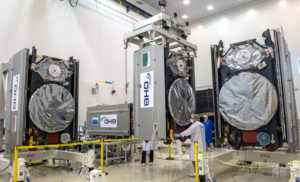The four Galileo satellites for Arianespace’s next Ariane 5 mission at the service of Europe’s navigation system are coming together in their flight configuration, while parallel preparations continue with the mission’s heavy-lift launcher.

In the Spaceport’s S1A clean room facility, the four Galileo FOC satellites are prepared for their fit-check evaluation with the mission’s payload dispenser
During pre-flight activity in French Guiana at the Spaceport’s S1A processing facility, these FOC (Full Operational Capability) spacecraft have undergone their fit-checks with the dispenser system to be installed on Ariane 5. Read more…





